Christmas Cactus Care: A Long-Lasting Succulent Houseplant
Christmas Cactus is an easy-care, attractive houseplant that can live for a long time. Here’s a simple guide on Christmas Cactus care during its blooming period and for the long term.
Do you want an excellent blooming plant for the holiday season? Well, look no further. Christmas Cactus, aka Holiday Cactus, is the one for you.
I happen to find this long-lasting succulent houseplant very attractive. Don’t send it to the compost after Christmas because it’s easy to care for and will grow for many years if maintained to its liking.
Christmas Cactus vs Thanksgiving Cactus
First off, let’s get a bit technical for those of you who geek out on all things plant as I do. My scarlet Christmas Cactus that you see in the lead photo above and in the video is a Thanksgiving (or Crab) Cactus.
It was labeled as a Christmas Cactus when I bought it and that’s how it’s commonly sold in the trade. Most of us want them to start their bloom in late November right after Thanksgiving so it’s one of those clever marketing things. You’ll see them appearing in garden centers, big box stores, and grocery stores just before Thanksgiving.
Nowadays, you may see them labeled for sale as Holiday Cactus. Regardless of which one you have, you care for these popular epiphytic cacti similarly.
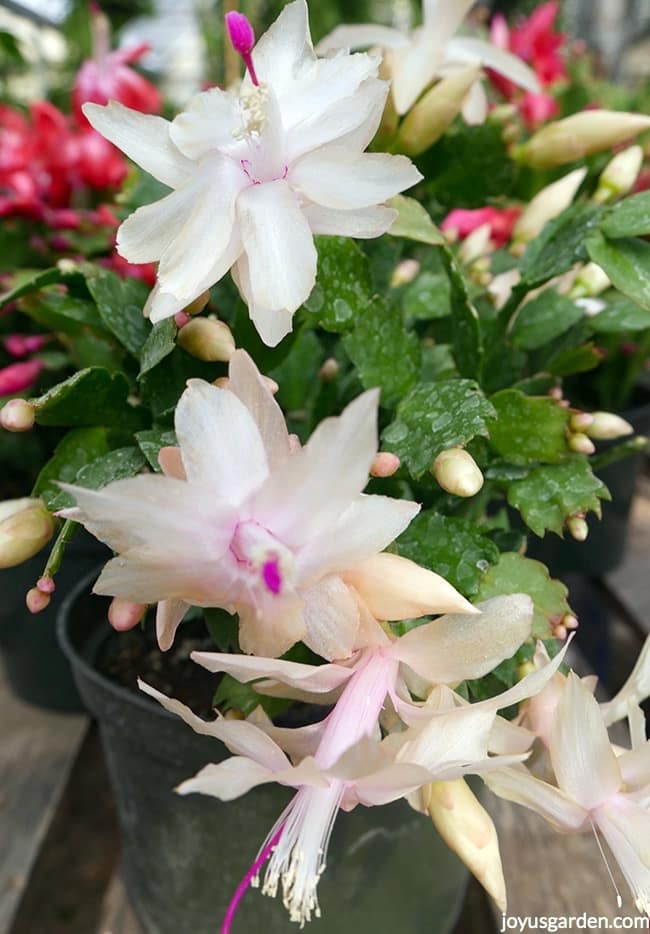
Both the Thanksgiving and the Christmas Cacti fall under the genus Schlumbergera, which I learned as Schlumbergia years ago. The Thanksgiving Cactus (Schlumbergera truncata) has little spine-like notches coming off its leaves, just like a crab claw hence that common name. The leaves of the Christmas Cactus (Schlumbergera bridgesii) are smoother and rounder.
The time of year for blooming is another difference. The Thanksgiving Cactus is timed to flower in late fall, November/December, whereas it’s December/January for the Christmas Cactus. An Easter Cactus is a bit harder to grow indoors and is timed to bloom in spring.
Christmas Cactus Care Video Guide
Other Christmas Cactus Care Guides: Getting Christmas Cactus To Bloom Again, Christmas Cactus Repotting, Christmas Cactus Propagation, Christmas Cactus Flowering More Than Once A Year, Christmas Cactus Leaves Turning Orange, & Answering Your Questions About Christmas Cactus
How To Care For Christmas Cactus
Below are things you should know about when growing and caring for Christmas Cactus plants. Enjoy!
Size
Christmas Cacti are most commonly sold in 4″ or 6″ pots. I’ve also seen them in 6″, 8″, and 10″ hanging baskets.
Many years ago I saw one in a greenhouse in Connecticut with quite a weeping form that was quite large. It was over 6′ wide. Yes, they can be long-lasting houseplants!
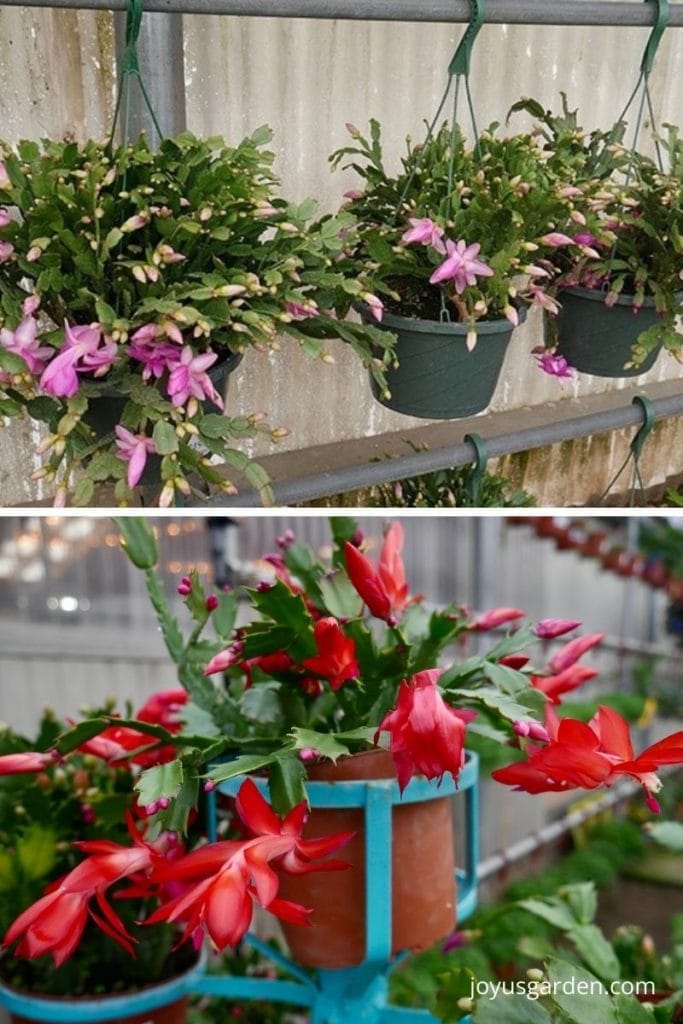
Light
They like and do best in bright, natural light; a medium to high light exposure. Be sure to keep them out of the direct sun and hot windows because their fleshy leaves will burn.
Although they don’t do well in full sun, they do need bright light to grow, bloom successfully, and stay looking good throughout the year. Like many houseplants, indirect sunlight is their sweet spot.
Mine grows on the bottom shelf of a long table in my dining room with quite a few other houseplants. It sits about 7′ away from a trio of south-facing windows in bright but indirect light.
Water
They are succulent plants. These epiphytic cacti differ from the desert cacti that I’m surrounded by here in Tucson. In their natural rainforest habits, Schlumbergeras grow on other plants and rocks; not in the soil.
This means their roots need to breathe. You don’t want to keep them constantly moist or they’ll eventually succumb to root rot.
Give yours a good drink and let all the excess water thoroughly run out of the drainage holes on the bottom of the pot. Allow the potting mix to go dry before you water it again.
Another reason not to keep them too wet is their susceptibility to fungus gnats. These pests don’t harm plants (or you), but they sure are annoying.
How often you water your Christmas Cactus depends on home temperature, the exposure it’s growing in, the pot size and type, and the soil mix it’s planted in.
I water mine growing in an 8″ pot every 2-3 weeks in summer and every 3-5 weeks in winter.
When your Holiday Cactus is blooming, water it a bit more often. After it has flowered, back off on the watering in winter. You can increase the watering frequency in spring and summer if need be.
My Christmas Cacti grew outdoors in terra cotta pots in my Santa Barbara garden. Yes, they do grow outdoors year-round in temperate climates. I watered them every week in the warmer weather and sometimes not at all in the winter, depending on if we had rain or not.
Looking for houseplant watering tips? Check out How to Water Indoor Plants
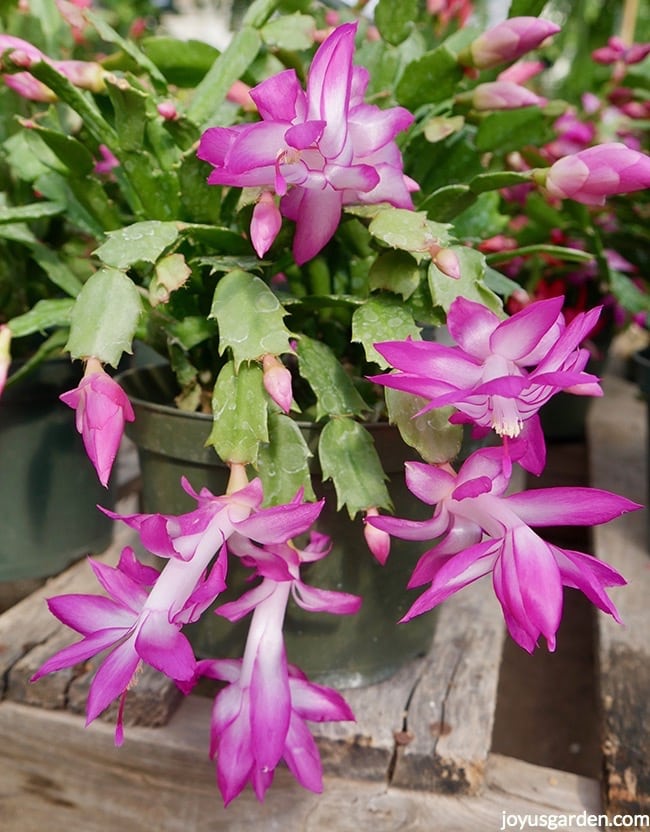
Temperature
In our homes, Christmas Cacti prefer warmer daytime temps (65 – 75) and to be kept cooler at night. They actually need those cool temperatures when setting their buds.
Santa Barbara winter temps could dip into the low 40s or high 30s and mine growing in the garden were fine. If yours has been outdoors for the summer, bring it into the house before the temperatures drop too low. They can’t take a freeze and definitely not a blanketing of snow.
A few years ago in mid-November November my Holiday Cactus here in Tucson was already half-bloomed out. The temps were in the low to mid-80s so I put it outside at night with temps around 55F to try and prolong the bloom a bit.
Just know that the warmer your house is, the quicker the blooming period will go by. Be sure to keep yours away from any heaters, and conversely, any cold drafts.
Humidity
These are tropical cacti so they prefer and do best with high humidity like the rest of your tropical houseplants. Our homes tend to be on the dry side so you may have to up the ante a bit with the humidity.
I live in the desert and have 3 Canopy humidifiers that I run in my kitchen, dining room/living room, and bedroom when the humidity inside gets below 30%.
If mine starts to look not as robust and a bit on the dry side, I’ll also put it on a saucer filled with pebbles and water. Be sure to keep the bottom of the pot out of the water because you don’t want any rotting.
I live in the Sonoran Desert. This is how I Increase The Humidity (or try to!) for my houseplants.
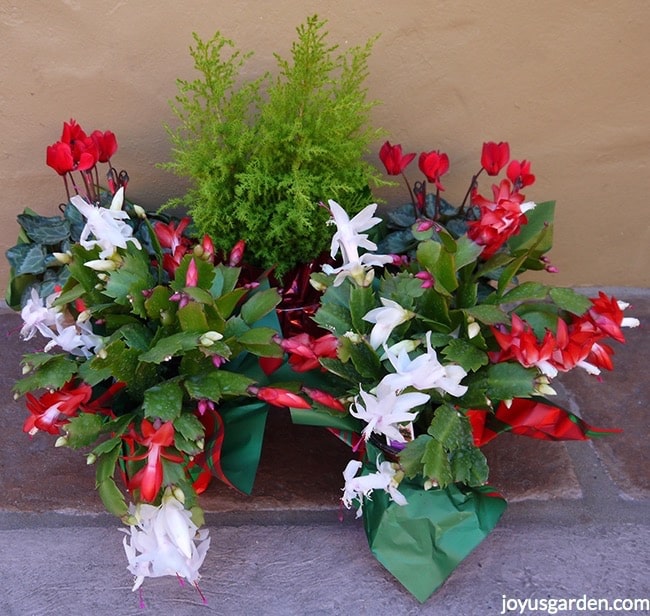
Fertilizing
I had never fertilized any of mine until I moved to Tucson. I always amended them with worm compost and organic compost every spring and still do. They always flowered fine. Here in the desert where it’s much hotter and drier, so I feed them a few times during the spring/summer.
Yours may not need it but if you like to fertilize, you can use a balanced liquid houseplant fertilizer (such as 10-10-10 or 20-20-20) in early spring, early summer, and mid-summer.
My friend used an all-around orchid fertilizer (20-10-20) on his Christmas Cactus once in spring and then again in summer and it looked great.
I now buy a combo of organic worm compost/compost at our farmers market. That’s what I use for spring feeding and repotting and planting. I also feed my Christmas Cactus 4 times a year March through September with Eleanor’s VF-11. I feel it needs a bit more nourishment because the climate here in Tucson is tougher on it than in more humid Santa Barbara.
As I’m updating this in 2022, Eleanor’s is unavailable. I’ve been using Maxsea All-Purpose instead.
Interested in more info on feeding houseplants? Be sure to check out How I Feed Indoor Plants.
Soil Mix
As I said, Holiday Cacti grow on other plants, rocks, and bark – they don’t grow in soil. In nature, they feed off leaf matter and debris. This means they like a very porous mix that also has some richness to it.
The potting mix needs to provide excellent drainage because the roots of a Christmas Cactus can’t stay constantly wet.
I use mostly DIY Succulent and Cactus Mix that is very chunky along with a bit of potting soil and compost mixed in. The DIY mix contains coco chips and coco fiber. This environmentally friendly alternative to peat moss is pH neutral, increases nutrient holding capacity, and improves aeration.
I’ve done a post and video dedicated to Repotting Christmas Cactus with more details to help you out.
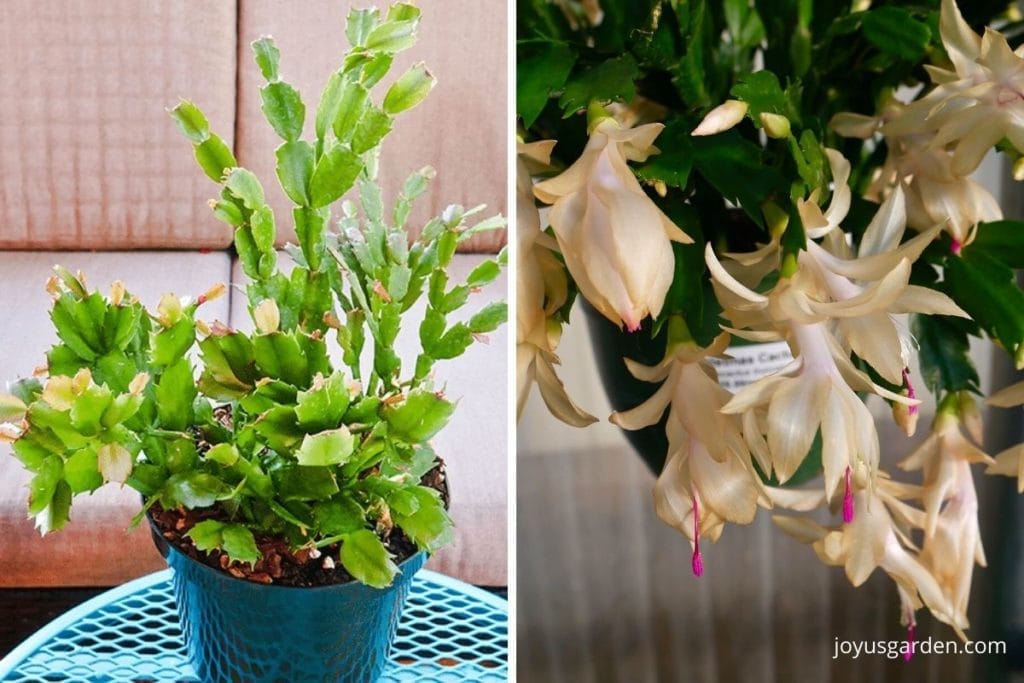
Pruning
The only reasons for pruning would be if yours needed taming due to spreading over time or if you want to propagate it.
Just be sure to cut or twist off whole leaf/stem sections. They’re easy to identify because of the indents.
Propagation
Like most succulents, a Christmas Cactus is very easy to propagate. You can do it by leaf segments (leaf cuttings) as well as by division.
As you’ll see in the video, mine is actually 3 plants growing in 1 pot. I could easily divide them by pulling the individual plants apart or by cutting the root ball carefully with a knife into 3 separate plants. I’d then plant them in separate pots in the succulent/compost mix.
You can take individual leaf cuttings by pruning the terminal leaf sections off. I prefer to twist them off whether it’s a single leaf or a segment of the stem.
The next step is to heal off the single leaves or stem segments for 5-7 days. Plant in that loose mix with about 1/2-2″ of the end sticking in depending on the size of the cuttings. Depending on your climate, they’ll start to root in 2-4 weeks.
I find that propagation is best done 2 to 4 months after the flowering has stopped. You’ll have new plants in no time!
I just touched on pruning and propagation here. Christmas Cactus Propagation has all the scoop just waiting for you!
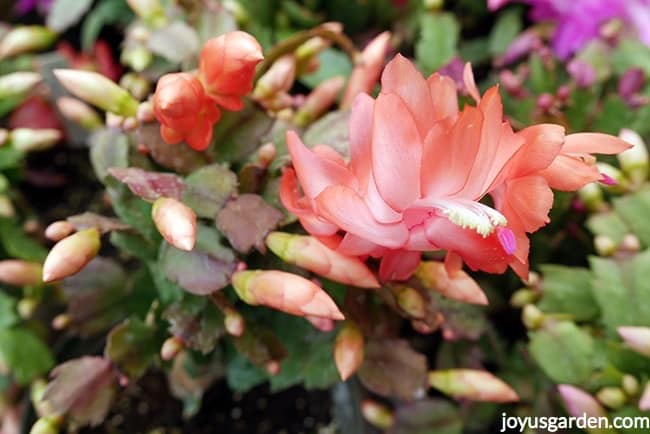
Pests/Problems
Mine has only gotten a touch of Mealy Bugs (they look like little specks of cotton) which simply I hose off. If that doesn’t get them, I dab them off with a cotton swab dipped into 1 part rubbing alcohol to 3 parts water.
Easy with the rubbing alcohol – it can burn a plant. You may want to test it out on a small section of the plant 1st and wait a few days to see how it reacts.
They’re also prone to Spider Mites. With any pest, you want to take action when you 1st see it because they spread like crazy.
Root rot or Fungus Gnats can be a problem if you keep them too wet. In the case of root rot, the plant starts to whither, wilts, and then eventually dies. This is a very good reason not to overwater this plant.
Flowering
Holiday Cacti, like Poinsettias, are photoperiodic. They require equal or longer periods of darkness to bloom again.
This means they need 12 – 14 hours of darkness per day to get those beautiful blooms. Start this reduction in light approximately 6-8 weeks, typically in early fall, before you want it to bloom.
Keep them drier during this process as this will help force them into dormancy. Water anywhere from every 4-6 weeks depending on the temps, the mix it’s in, and the size and type of pot it’s planted in.
You want to keep the temps between 50 and 65 degrees F if you can. 50-55 degrees is best at night. If your temps are warmer, they’ll require a longer period of darkness.
It can take a bit of effort to move yours into a closet or basement every night but perhaps you have a spare room that naturally has these conditions.
After the flower buds start to appear, then them can move them back to a bright spot, resume the care you were previously giving them, and enjoy the beautiful flowers.
This is a common problem that some people have so I want to touch on it. If the buds on your Christmas Cactus are falling off before they open, it could be because it’s too wet or it’s gone through some type of environmental stress (temperature fluctuations, too much sun, cold drafts, etc).
The flower colors vary. I’ve seen them in red, violet, white, peach, orange, yellow, pink, and bi-color.
By the way, my Christmas Cacti grown outdoors in Santa Barbara bloomed on their own. Mother Nature handles the darkness in the fall!
It takes a bit of effort, but here’s How To Get Christmas Cactus To Bloom Again.
Pet Safety
Bravo! Holiday Cacti are non-toxic to both cats and dogs. You and your pets can enjoy them with no worries.

Some Of Our General Houseplant Guides For Your Reference:
- Guide To Watering Indoor Plants
- Beginner’s Guide To Repotting Plants
- 3 Ways To Successfully Fertilize Indoor Plants
- How to Clean Houseplants
- Winter Houseplant Care Guide
- Plant Humidity: How I Increase Humidity For Houseplants
- Buying Houseplants: 14 Tips For Indoor Gardening Newbies
- 11 Pet-Friendly Houseplants
More Christmas Cactus Care & Growing Tips
Don’t rush to Repot Your Christmas Cactus. It’ll bloom better if slightly pot-bound. Every 3-5 years is best, depending on how fast it’s growing. Repotting it 2-3 months after bloom time is best.
If your Holiday Cactus is Changing Color, usually to an orangish/reddish/or brownish hue, that means it’s stressed. Common causes are too much sun or too little water.
Water yours a bit more often when it’s flowering.
If you water one too often, plainly put, it’ll mush out.
Conversely, too little water will cause it to shrivel and change color.
You can get a Thanksgiving Cactus to bloom a bit later by keeping it cool – 50 to 55F. The flowers will open slower and last longer.
Spent flower blossoms can be removed by holding on to the leaf section and gently twisting them off.
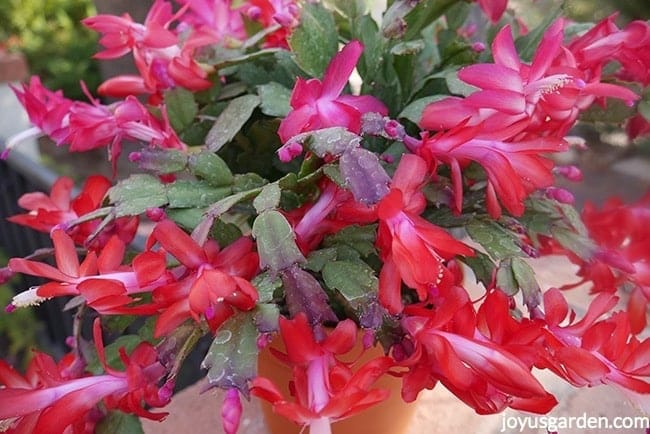
Whether you call them Christmas Cacti, Thanksgiving Cacti, or Holiday Cacti, the care is the same for this beautiful plant. The Thanksgiving Cactus blooms about 3-4 weeks earlier than the Christmas Cactus and is popular because most people want to get a jump on their Christmas flowers.
I was told by a grower that Thanksgiving Cacti ship easier because they’re not as pendulous as Christmas Cacti and the leaves tend not to break off.
Whichever one you have, it makes a long-lasting houseplant. Christmas Cactus care is easy and they’re wonderful when in bloom. I think I need (want!) to get another one – how about you?
Happy gardening,


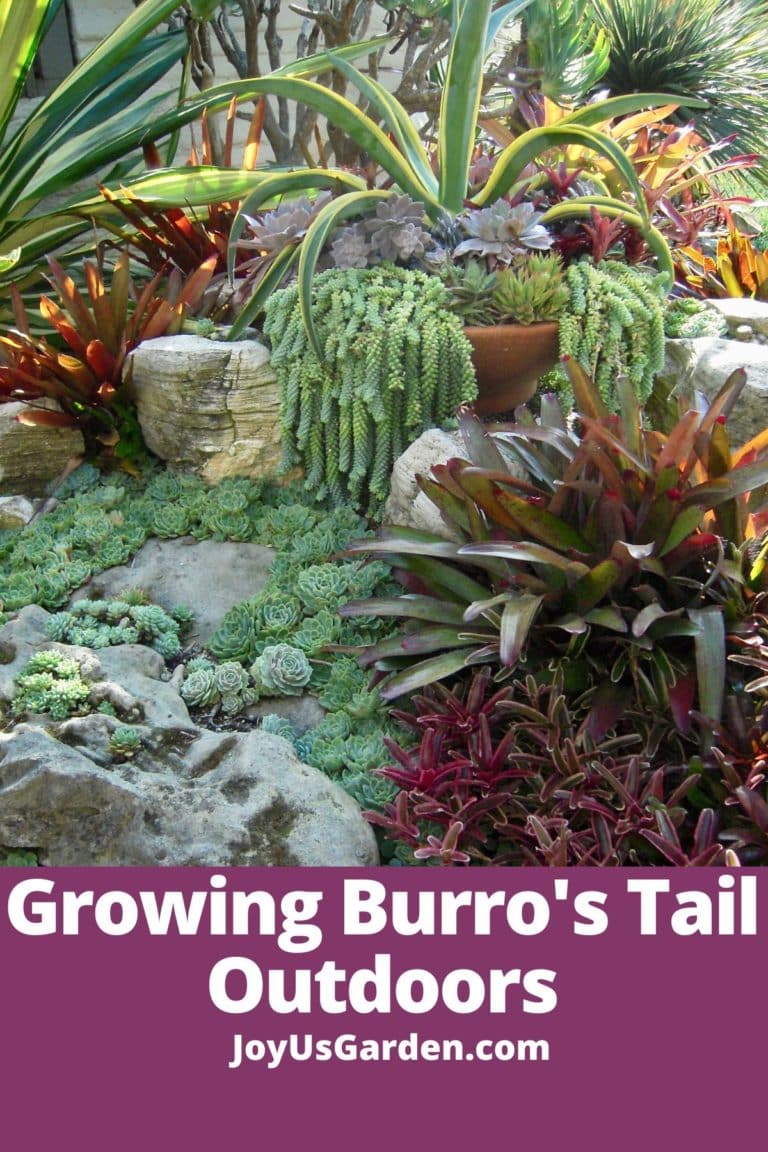
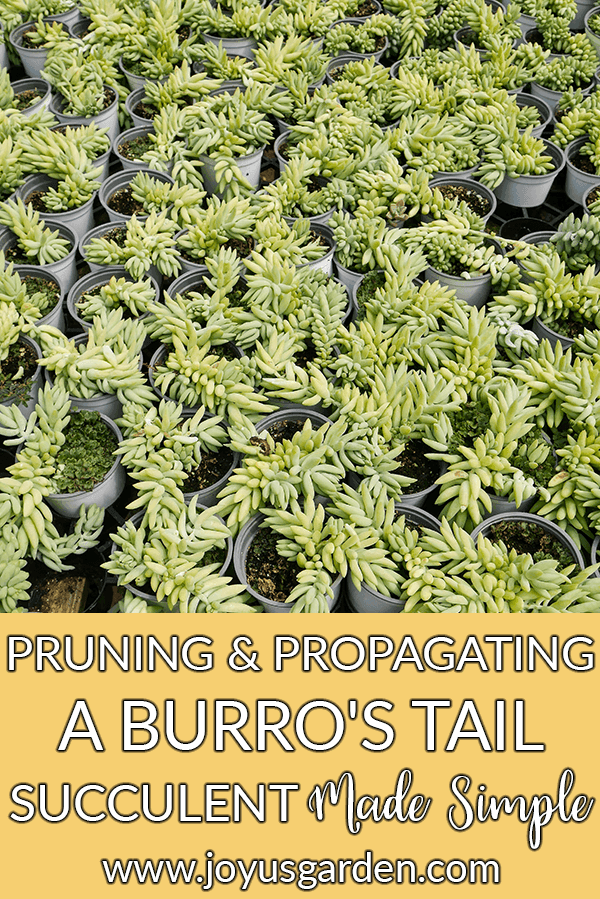
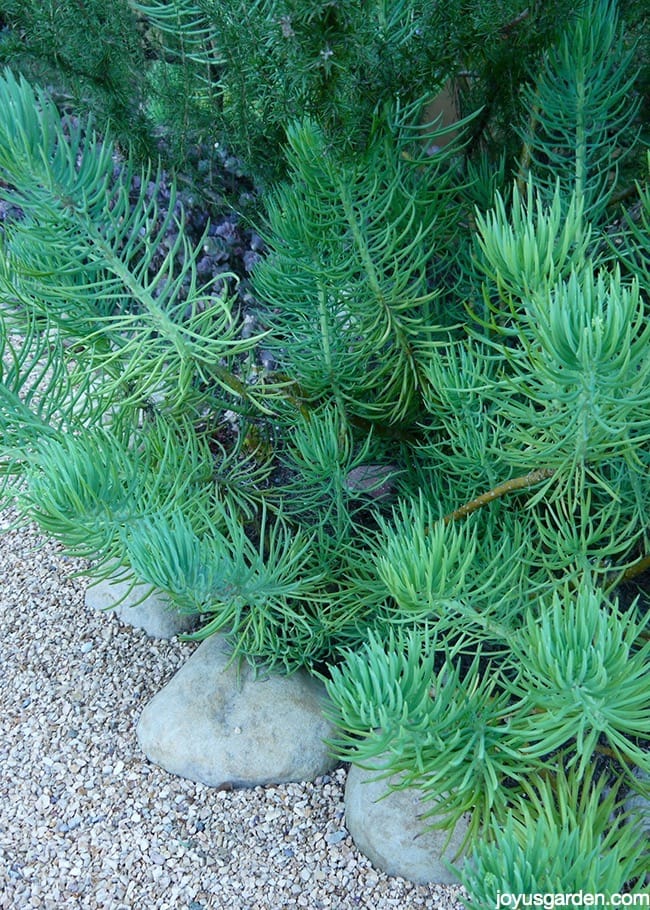
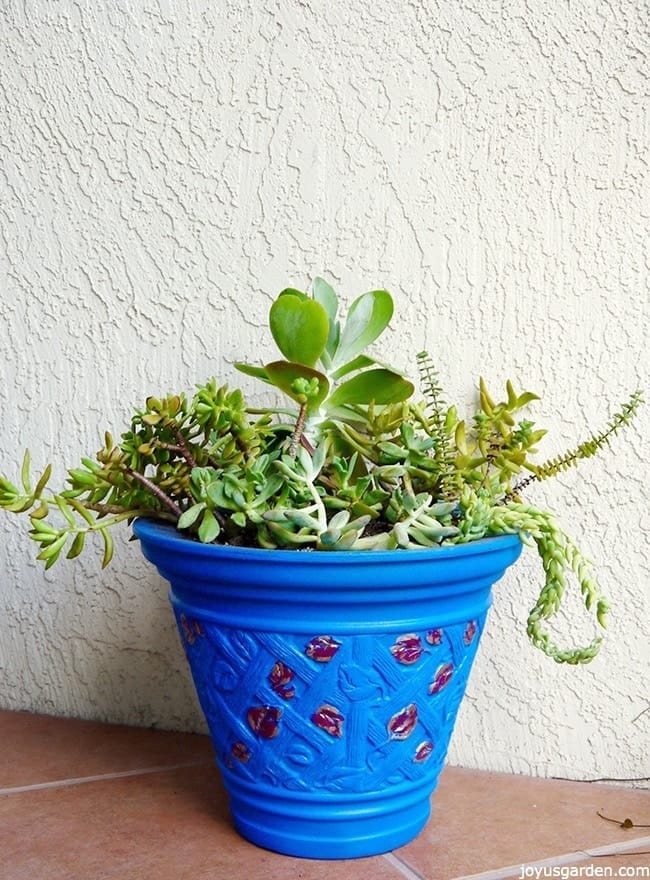

UPS left a gift holiday cactus on my porch, with no warning, and it partially froze., overnight. One side of it seems to be surviving, but the other side has dead, limp leaves. Should I cut these off? I would appreciate any suggestions.
Hi Carol – You can cut away those dead, limp leaves. If there is a node or 2 towards the base which isn’t dead & limp, then leave it/them. The roots may not have frozen so new growth may appear as spring approaches. The good news is that HC propagates very easily so as the other side grows, you can take cuttings to fill in the plant. I’m doing a post on propagating 1 in the next 3-5 weeks. Nell
My Christmas cactus is about 4 years old and puts on a show when in bloom. Last year, for the first time, I noticed it re-budding, as the blooms were starting to dry out but the buds all dried out and dropped. This year, again, it’s re-budding but the buds look as if they might survive and go into full bloom, is that usual?
Hi Gloria – Yes, it can happen. The buds falling off are due to environmental stress like change in temperature or light exposure, air too dry, or if the plant was moved while those buds were setting. Those are the reasons I know of. Nell
Hi Carol-I was wondering if these would grow in the water beads.
Not that I’m aware of Jackie. I propagate mine in mix but I know some people do it in water. In regards to growing for the long haul, I’d stick to mix. Nell